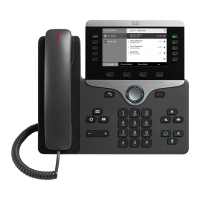Configure Network Settings, on page 50
Phone Startup Verification, on page 65
VLAN Interaction, on page 17
Cisco Unified Communications Manager Interaction, on page 17
Cisco Unified Communications Manager Express Interaction, on page 18
Set Up the Audio and Video Port Range, on page 176
Cisco Unified Communications Manager Documentation, on page xvii
VLAN Interaction
The Cisco IP Phone contains an internal Ethernet switch, enabling forwarding of packets to the phone, and
to the computer (access) port and the network port on the back of the phone.
If a computer is connected to the computer (access) port, the computer and the phone share the same physical
link to the switch and share the same port on the switch. This shared physical link has the following implications
for the VLAN configuration on the network:
•
The current VLANs might be configured on an IP subnet basis. However, additional IP addresses might
not be available to assign the phone to the same subnet as other devices that connect to the same port.
•
Data traffic present on the VLAN supporting phones might reduce the quality of VoIP traffic.
•
Network security may indicate a need to isolate the VLAN voice traffic from the VLAN data traffic.
You can resolve these issues by isolating the voice traffic onto a separate VLAN. The switch port to which
the phone connects would be configured for separate VLANs for carrying:
•
Voice traffic to and from the IP phone (auxiliary VLAN on the Cisco Catalyst 6000 series, for example)
•
Data traffic to and from the PC that connects to the switch through the computer (access) port of the IP
phone (native VLAN)
Isolating the phones on a separate, auxiliary VLAN increases the quality of the voice traffic and allows a large
number of phones to be added to an existing network that does not have enough IP addresses for each phone.
For more information, see the documentation that is included with a Cisco switch. You can also access switch
information at this URL:
http://cisco.com/en/US/products/hw/switches/index.html
Cisco Unified Communications Manager Interaction
Cisco Unified Communications Manager is an open, industry-standard call processing system. Cisco Unified
Communications Manager software sets up and tears down calls between phones, integrating traditional PBX
functionality with the corporate IP network. Cisco Unified Communications Manager manages the components
of the IP telephony system, such as the phones, the access gateways, and the resources necessary for features
such as call conferencing and route planning. Cisco Unified Communications Manager also provides:
•
Firmware for phones
•
Certificate Trust List (CTL) and Identity Trust List (ITL) files using the TFTP and HTTP services
•
Phone registration
Cisco IP Phone 8800 Series Administration Guide for Cisco Unified Communications Manager
17
VLAN Interaction

